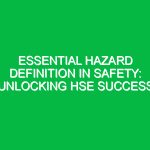Understanding Hazard Hierarchy in the HSE Context
In the realm of Health, Safety, and Environment (HSE) practices, understanding the concept of hazard hierarchy is paramount. This systematic approach prioritizes the identification and management of hazards, ensuring a safer working environment. The hazard hierarchy, often depicted as a pyramid, organizes various control measures from the most effective to the least effective. This article delves into the intricacies of hazard hierarchy, exploring its significance, components, and practical applications within the HSE framework.
The Components of Hazard Hierarchy
The hazard hierarchy consists of several layers, each representing a different level of risk management. These layers, listed from most to least effective, are:
- Elimination
- Substitution
- Engineering Controls
- Administrative Controls
- Personal Protective Equipment (PPE)
1. Elimination
Elimination is the most effective control measure. It involves completely removing the hazard from the workplace. For instance, if a specific chemical poses a risk to employees, finding a way to eliminate its use altogether can significantly enhance safety. A case study from a manufacturing plant demonstrated that by transitioning to a water-based adhesive instead of a solvent-based one, the company eliminated the risk of chemical exposure entirely. Such proactive measures not only safeguard employees but also contribute to environmental sustainability.
2. Substitution
When elimination isn’t feasible, substitution is the next best option. Substitution entails replacing a hazardous material or process with a less hazardous one. For example, a construction company might replace a high-noise machine with a quieter model to reduce noise-related health risks. This method maintains productivity while reducing potential harm to workers.
3. Engineering Controls
Engineering controls involve modifying the workplace or equipment to minimize exposure to hazards. This might include installing ventilation systems to remove airborne contaminants or using machine guards to protect workers from moving parts. A practical example can be seen in the automotive industry, where robotic assembly lines are used to limit human interaction with hazardous machinery, thus lowering the risk of accidents.
4. Administrative Controls
Administrative controls focus on changing how people work. This can include implementing safety training programs, establishing work schedules that limit exposure, or enforcing strict safety protocols. For instance, a mining company may rotate workers through different tasks to prevent overexposure to hazardous conditions, such as dust or noise.
5. Personal Protective Equipment (PPE)
While PPE is the last line of defense in the hazard hierarchy, it plays a crucial role in protecting workers. This includes items such as helmets, gloves, goggles, and respirators. Although PPE is essential, it should not be the sole method of hazard control. The effectiveness of PPE relies heavily on proper training and consistent use, as evidenced by numerous workplace incidents where lack of compliance led to injuries.
Benefits of Implementing Hazard Hierarchy
Implementing a robust hazard hierarchy offers numerous benefits to organizations, employees, and the environment. A few key advantages include:
- Enhanced Safety: By prioritizing the most effective control measures, organizations can significantly reduce workplace injuries and illnesses.
- Compliance with Regulations: Following a structured approach to hazard management helps organizations meet legal and regulatory requirements.
- Improved Productivity: A safer workplace leads to fewer accidents, thereby enhancing overall productivity and morale among employees.
- Cost Savings: Reducing workplace incidents can lead to lower insurance premiums and less money spent on medical costs and legal fees.
- Environmental Protection: Minimizing hazards often results in less environmental impact, promoting sustainability.
Best Practices for Implementing Hazard Hierarchy in HSE
To effectively integrate hazard hierarchy into HSE practices, organizations should consider the following best practices:
1. Conduct Regular Risk Assessments
Regular risk assessments are crucial for identifying potential hazards in the workplace. By systematically evaluating risks, organizations can prioritize their hazard control measures effectively. For instance, an oil refinery might conduct frequent assessments to identify new hazards associated with changing processes or materials.
2. Foster a Safety Culture
Creating a culture of safety within the organization encourages employees to prioritize safety in their daily activities. Encouraging open communication about safety concerns empowers employees to contribute to hazard identification and control efforts. A construction firm that regularly holds safety meetings and encourages worker feedback often sees a marked improvement in safety practices.
3. Provide Comprehensive Training
Training is essential to ensure that employees understand the hazards they face and the measures in place to mitigate them. Comprehensive training programs that include practical demonstrations can enhance workers’ knowledge and compliance with safety protocols. For instance, a chemical plant might provide hands-on training sessions for employees on how to use PPE effectively.
4. Review and Update Procedures Regularly
The workplace is dynamic; therefore, hazard control procedures should be reviewed and updated regularly. This ensures that the measures in place remain effective and relevant. A notable example is a pharmaceutical company that revises its safety protocols annually based on incidents and feedback from employees, ensuring continuous improvement.
5. Engage Employees in Safety Initiatives
Involving employees in safety initiatives fosters a sense of ownership and accountability. Encouraging workers to participate in safety committees or hazard identification teams can lead to innovative solutions and improved safety practices. For instance, a manufacturing company that empowers its workers to identify potential hazards often discovers issues that management might overlook.
Regulations and Standards Governing Hazard Hierarchy
Various regulations and standards govern the implementation of hazard hierarchy in the HSE domain. These include:
- Occupational Safety and Health Administration (OSHA): OSHA provides guidelines and standards that require employers to adhere to effective hazard control measures.
- ISO 45001: This international standard outlines requirements for an occupational health and safety management system, emphasizing the importance of risk assessment and hazard hierarchy.
- National Fire Protection Association (NFPA): NFPA codes emphasize hazard assessment and control, particularly in industries where fire risks are prevalent.
Compliance with these regulations not only enhances workplace safety but also protects organizations from legal repercussions and financial liabilities.
Conclusion
In conclusion, the essential hazard hierarchy serves as a foundation for effective health, safety, and environmental practices. By prioritizing the most effective control measures and fostering a culture of safety, organizations can significantly reduce workplace hazards and promote a safer and more productive environment. The integration of regular risk assessments, comprehensive training, and employee engagement further enhances the efficacy of hazard management strategies. Ultimately, embracing the principles of hazard hierarchy is not just about compliance; it is about valuing the well-being of employees and the environment. As we move forward, let us continue to prioritize safety, ensuring that every worker returns home safely at the end of the day.


